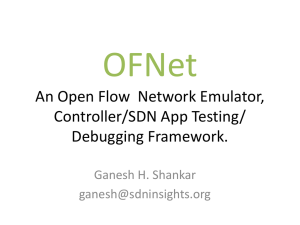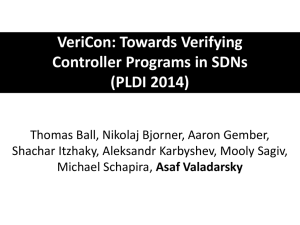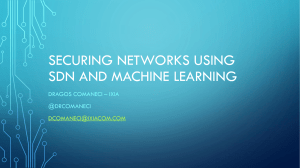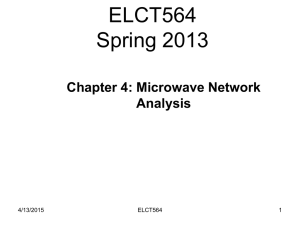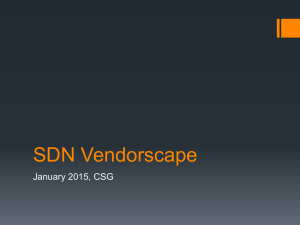asiafi2013school_submission_12
advertisement
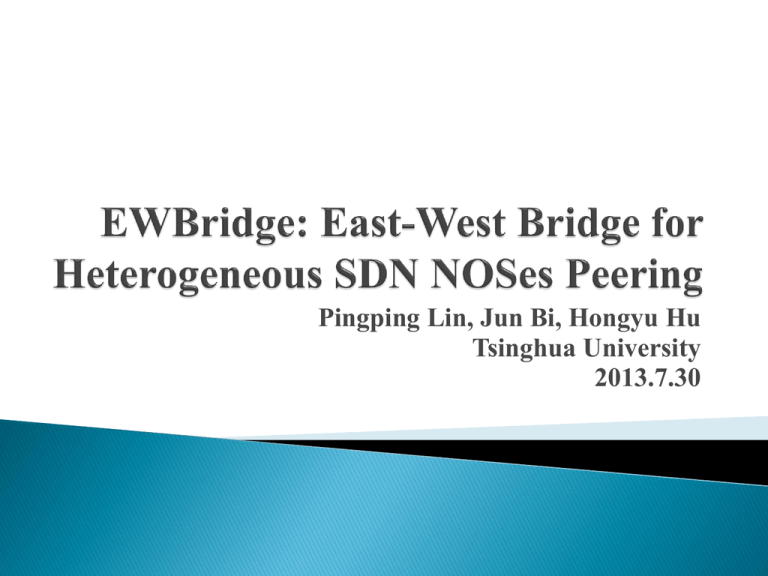
Pingping Lin, Jun Bi, Hongyu Hu Tsinghua University 2013.7.30 Software defined networking (SDN) decouples the vertical and tightly coupled network architecture, and opens up the control plane and the associated protocol. In this way, SDN promotes the rapid innovation and the evolution of the network. SDN is considered as a promising way to re-architect the networks. Large networks are always partitioned into several small networks when deploying SDN: ◦ ◦ ◦ ◦ Scalability. Privacy. Incremental deployment. Network faults isolation. A dedicated network operating system (NOS) or controller is deployed for each network. Each NOS has the local network view. However, to route data packets in an entire network, a global network is required. We divide SDN domains(sub-networks) into 4 categories, referred to as SDN Peers: ◦ SDN AS Peers ◦ SDN intra-domain sub-network Peers belonging to the same administrative domain ◦ DCs of an individual company located at different places ◦ Enterprise networks located at different areas connected by the WAN. This paper focuses on the latter three scenarios. Define what network information and how such information be exchanged. Design a performance mechanism (EWBridge) for network view exchange from multi-domain networks. Enable multiple heterogeneous NOSes to work together. ◦ EWBridge should be compatible with different third-party controllers’ network view information storage systems. There two types of NOS: (1) Single NOS ◦ Floodlight , NOX , Maestro, Beacon, SNAC, and Trema. (2) Distributed NOS ◦ Onix, HyperFlow, and DIFANE. Single NOS improves performance by technologies like multi-thread running on a multi-core server. However, for large-scale data centers or networks, the capability of a single controller is limited: ◦ NOX could process about 30K requests per second; ◦ Maestro could process about 600K requests per second. To achieve a scalable control plane, distributed NOSes are proposed. Name Technology for network View/event sync Evaluation HyperFlow WheelFS (distributed file system ) can only deal with non-frequent events Onix DHT (Distributed Hash Table) A powerful controller; Did not prove the performance of DHT in large scale network None of them can coexist with others, because the eastwest communication interface is private. Yin et al. had proposed a message exchange protocol SDNi for SDNacross multiple sub-network domains. ◦ only defined several basic messages such as the reachability information and the flow setup/ tear-down/ update processes. What network information and how such information be exchanged has not been well addressed so far. East-west Bridge (EWBridge) for heterogeneous NOSes cooperation in SDN Before exchanging the network view, the first task for controllers is to discover each other. The controller discovery algorithms can be: ◦ distributed controller discovery algorithm ◦ centralized management system such as a registration center Since this paper focuses on a same administrative network (intra-domain/ enterprise/ DC), a registration server is adopted. A reference for controller list information: <Controller_ID, name, version, IP_address, is_TCP, is_RestAPI, TCP_port, Rest_port>. Static state information ◦ Reachability: in carrier network, reachability refers to the IP address prefixes; in DC and enterprise network, it also includes the server/host addresses. ◦ Topology: node (e.g., switch, server, host, controller, even firewall, balancer, others), link, link bandwidth, port throughput, link connection. ◦ Network service capabilities: such as SLA, GRE. ◦ QoS parameters: such as latency, reliability, packet loss rate, availability, throughput, time delay variation, and cost. Dynamic state information: ◦ Mainly includes two aspects: ◦ network state: such as FlowTable entries information in each switch; ◦ real-time bandwidth utilization in the topology, and the all the flow paths in the network. We formalize the network view by directed graph with entity (node, virtual node, link, virtual link). Considering that the network storage should have a higher scalability, availability and data IO speed, EWBridge suggests the ‘key-value’ database plus caching systems. Databases with transactional function should be adopted to guarantee data integrity. Key Node_ID (physical/virtual) is_ virtual (first column) Link_ID (physical/virtual) is_ virtual (first column) Port_ID (physical/virtual) is_ virtual (first column) Node_capbility Reachability Columns IP_addresses, OF_version, port_numbers, is_edge_node, Vendor_name, MTU Device_type, Device_function Node_ID_src, Port_ID_src, Node_ID_dst, Port_ID_dst, Bandwidth, is_interdomain_link Node_ID, Port_MAC, is_active, is_edge_port, VLAN_ID, throughput protocol_name, version, port IP_prefixes, length Node_table_ID (Flow entity) Columns names are the same as the fields defined in the flowtable in OpenFlow specification Link_Utilities Link_ID, Link utilities Flow_path (Node_ID_src_ Node_ID_dst) Port_ID (in), Node_ID_src, Port_ID (out), Node Series with ingress and egress ports, Port_ID (in), Node_ID_dst, Port_ID (out) Enable EWBridge in all kinds of NOSes by adding three modules: ◦ Network Virtualiztion, East-West Bridge, and LLDP Extension The basic information such as node, node_capbility, port, and link information usually can be learned by the LLDP . To learn more network view information such as ◦ OpenFlow version, number of the FlowTables on each node, link utilities, and flow entries. We extended the NOS by adding a network view driver module named ‘LLDP extension’. ◦ By counting the total number of packets related to a port in all the FlowTables, the driver can learn the link utilities. ◦ By certain commands (OpenFlow switches provide those commands) to switches, the OpenFlow version, number of FlowTables, and flow entries can be learned. This paper suggests JSON as a basic implementation, and the XML, YANG, YAML as alternatives. Those languages have the ability to enable EWBridge with the following advantages: ◦ (1) vendor and application-independent, thus the network view transfer format is independent with the storage systems; ◦ (2) allow explicit definition of the inherent structure according to the requirements; such features make the network view message format flexible and easy to extend; ◦ (3) They are files and not a data packet format. The elements are easy to extend. Some domains may be willing to expose only a part of the network view due to their privacy concerns. EWBridge supports abstracting a physical network to a virtual network for such domains. For the virtual network view, there is a mapping table between the physical network and the abstracted virtual network views. Physical view to virtual view (PP: Physical Path; VP: Virtual Path; OF: OpenFlow; S: Switch; bd: bandwidth; t: time; bps: bits per second) After the controller discovery process, each controller learns all the addresses of their peers. Then all the controllers can establish a virtual full mesh topology based on TCP/ SSL. All the SDN peers are equal to each other. For the network event such as link failure, adding/ deleting switch, adding/ deleting IP prefixes, each controller can subscribe to other controllers’ events. Publish/ subscribe system to deliver update messages: ◦ Once an event is triggered, the corresponding controller will push the event to all the subscribers simultaneously. ◦ Each controller can get the update message directly from the controller it cares. We design a FSM with 5 messages: OPEN, UPDATE, NOTIFICAION, KEEPALIVE, VIEW-REFRESH. Compared with BGP FSM, EWBridge mainly changes the UPDATE message into JSON file format, and simplifies the finite state machine. To achieve high speed data exchange: ◦ In the normal condition, all the NOSes keep in connections. By sending KEEPALIVE messages. ◦ Once network view updates, EWBridge can send UPDATE file out to its peers in parallel without re-setup TCP connections. ◦ Each UPDATE file carry multiple UPDATE messages. We are going to deploy the EWBridge to connect three SDN networks: SDN networks in CERNET, INTERNET2, CSTNET, and running the cross-domain path computing application. Speed of Network view updates. EWBridge adopts the subscribe/ publish model. Once a network view changes, the controller directly pushes the change to their peers with time: return(t). DHT needs to fetch the data in distributed locations: request(t) + return(t). So EWBridge is request(t) faster than DHT. Network view updates bandwidth cost. we define the update frequency as 1/f per second, and the number of NOSes is n. Then, in time 1/f , the amount of link utility change in each domain is: EWBridge will transfer information: while DHT is: Thus, EWBridge is less than DHT by: Data query speed. ◦ The EWBridge and DHT are both based on the “key-value” storage system. ◦ But DHT has routing issues (multi-hop routing), while EWBridge is single-hop routing. a hop may really mean multiple physical hops in the underlying network ◦ So EWBridge is faster than DHT in the data query speed. Then there will be about domains. The total number of connections is: Normally, one client uses one computer at the same time and we assume each computer generate 1 request per second. According to the well-known NOX as controller, and NOX could process about 30K request per second. In DC/AS, the online people are usually less than 3,000,000 (from Caida) Number of domain and connection degree: About 100% of enterprises and data centers, and about 99.5% of ASes can adopt the EWBridge full mesh solution. According to the best of our knowledge, this is the first time to propose different NOSes working together. In the future, we are going to deploy it to three SDN networks: SDN networks in CERNET, INTERNET2, and CSTNET.
